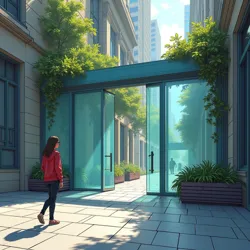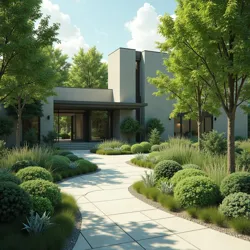Visual Respite Zones
 A designated Visual Respite Zone entrance featuring specialized cognitive shielding technology
A designated Visual Respite Zone entrance featuring specialized cognitive shielding technologyVisual Respite Zones (VRZs) represent one of the last bastions of unmonetized cognitive space in the modern attention economy. These carefully regulated areas provide essential relief from the constant barrage of commercial messaging and attention harvesting that characterizes contemporary urban environments. First established in 2038 as a response to rising rates of Attention Fatigue Syndrome, these zones have become crucial infrastructure for maintaining public mental health and cognitive sustainability.
Origins and Development
The concept of Visual Respite Zones emerged from early research conducted by the Neo-Minimalist Movement into the psychological impacts of sustained exposure to commercial attention capture. Initial studies revealed alarming rates of cognitive deterioration among urban populations subjected to continuous attention harvesting, leading to the development of protected spaces specifically designed to allow natural mental recovery.
The first experimental VRZ was established in New Shanghai following a series of mass psychological events linked to overexposure to Volumetric Attention Mapping systems. The immediate positive impact on public mental health led to rapid adoption of the concept in other major metropolitan areas. Today, international law requires all cities above a certain population threshold to maintain a minimum ratio of Visual Respite Zone space relative to commercially exploited cognitive territory.
Technical Implementation
Creating and maintaining effective Visual Respite Zones requires sophisticated technological infrastructure to counter the pervasive nature of modern attention harvesting systems. The zones employ advanced Neural Dampening Fields to suppress incoming commercial signals while allowing natural sensory processes to function normally. These fields must be carefully calibrated to avoid interfering with essential emergency broadcasting systems while still providing comprehensive protection from unwanted attention capture attempts.
The physical boundaries of VRZs are typically marked by specialized cognitive shielding barriers that create a gradual transition between heavily monetized spaces and the protected interior of the zone. This graduated approach helps prevent the psychological shock that can occur when moving between areas of radically different attention density. The technology builds upon research in Surface Categorization Protocol but inverts its typical application to create spaces specifically designed to resist attention mapping and harvesting.
Spatial Design and Architecture
Visual Respite Zones employ distinctive architectural principles aimed at promoting natural attention patterns and cognitive recovery. Buildings within these areas must adhere to strict guidelines that prohibit any surfaces or structures capable of supporting commercial messaging or attention capture technologies. This has led to the development of new architectural styles specifically optimized for attention neutrality, often incorporating natural materials and organic forms that resist commercial exploitation.
The layout of VRZs typically includes carefully planned sight lines and visual corridors that guide attention in natural, unforced patterns. These designs often incorporate elements from traditional contemplative spaces while integrating modern understanding of cognitive flow dynamics. Water features, green spaces, and other natural elements are commonly used to provide gentle attention anchors that help visitors maintain mental focus without commercial interference.
Social and Economic Impact
 A meditation garden within a Visual Respite Zone designed to facilitate natural attention patterns
A meditation garden within a Visual Respite Zone designed to facilitate natural attention patternsThe establishment of Visual Respite Zones has had profound effects on urban social dynamics and economic structures. Property values adjacent to VRZs have seen consistent appreciation, despite their inability to host traditional attention harvesting infrastructure. This has led to the emergence of a new category of premium real estate marketed specifically to individuals seeking proximity to cognitive protection zones.
The zones have also given rise to new forms of social interaction and community organization. Regular VRZ users often form informal groups and communities centered around shared experiences of unmediated consciousness. These communities have become important advocates for the preservation and expansion of protected cognitive spaces, often acting as counterweights to commercial interests in urban planning discussions.
Regulatory Framework
The management and protection of Visual Respite Zones falls under the jurisdiction of the International Commission for Cognitive Rights (ICCR), which establishes global standards for zone designation and maintenance. These regulations include strict limits on the types of technology that can be operated within zone boundaries and specific requirements for cognitive shielding infrastructure.
Enforcement of VRZ regulations has become increasingly complex as attention harvesting technologies grow more sophisticated. The ongoing battle between zone protection systems and attempts at commercial penetration has led to an arms race in cognitive shielding technology. This has required regular updates to international standards and continuous investment in protection infrastructure.
Medical Applications
The therapeutic potential of Visual Respite Zones has become increasingly recognized by medical professionals specializing in cognitive health. Many hospitals and mental health facilities now incorporate private VRZs into their treatment facilities, using these protected spaces as essential components in the treatment of attention-related disorders and cognitive stress conditions.
Research has shown that regular access to Visual Respite Zones can significantly reduce the incidence of Perceptual Burnout Syndrome and other attention-related health conditions. This has led to the integration of VRZ access into many corporate health plans and public health initiatives, despite resistance from attention industry lobbyists.
Challenges and Controversies
The establishment and maintenance of Visual Respite Zones faces ongoing challenges from commercial interests seeking to exploit these valuable urban spaces. Attempts to circumvent zone protections through increasingly sophisticated attention capture technologies have led to an endless cycle of security updates and countermeasures. The cost of maintaining effective cognitive shielding has become a significant burden for many municipalities.
Some critics argue that the very existence of Visual Respite Zones represents a tacit acceptance of excessive commercialization in other urban spaces. These voices advocate for more comprehensive restrictions on attention harvesting throughout urban environments, rather than the creation of limited protected zones.
See Also
- Attention Fatigue Syndrome
- Surface Categorization Protocol
- Volumetric Attention Mapping
- Neo-Minimalist Movement
- Perceptual Burnout Syndrome
References
- "The Essential Role of Visual Respite Zones in Urban Mental Health" - Journal of Cognitive Sustainability, 2042
- "Designing for Attention Protection: A Technical Guide to VRZ Implementation" - International Commission for Cognitive Rights, 2043
- "Economics of Protected Cognitive Space" - Global Attention Exchange Quarterly, 2041